A new Supreme Court term is once again underway. This one looks to be unique in that it is likely to be an eight-Justice bench into 2017—with Republican leaders standing firm on their refusal to go forward with confirming any nominee appointed by President Obama, it is likely that any new ninth justice will have to wait until after inauguration day to even receive a hearing, much less take the bench.
Justice Scalia’s absence has had at least some effects on the cases that the Court has taken and decided: the Supreme Court has taken cases at a slower pace than in recent years, and toward the end of the last term, showed signs of trying to dispose of cases on narrow grounds that could avoid a 4-4 deadlock. While the docket is thinner than in years past, and while the Court may decide some of its cases on narrower grounds that can get broader support from the eight Justices, the Court still has cases on its docket that the automotive industry should watch carefully. Three of these case include:
-
Samsung Electronics Co. v. Apple, No. 15-777: Design patents, as the name suggests, cover the design of a product, rather than its utility. A hot issue for the automotive industry, design patents also lie at the heart of long-simmering litigation between these giants of the electronics industry. The Supreme Court is now set to decide an issue regarding the damages to be awarded for infringement of a design patent: whether the design patent owner is entitled to all of the profits the infringing party makes from the sale of a product containing an infringing feature, or just the portion of the profits attributable to that infringing feature. Like smartphones, automobiles (and even portions of automobiles) are complex devices, with several components that each have their own design features; the outcome in this case could help decide what the legal landscape for design patent protection in the automotive sector looks like going forward.
-
SCA Hygiene Products Aktiebolag v. First Quality Baby Products, LLC, No. 15-927: Samsung isn’t the only case that promises to have ripple effects on intellectual property enforcement. The question in SCA Hygiene is whether laches—a defense similar to a statute of limitations, which kicks in where a court determines that a plaintiff delayed his infringement suit and prejudiced defendant by doing so—can cut off a patent infringement claim, even before the six-year statute of limitations set out in the Patent Act expires. The answer may help determine the exposure a defendant faces in a suit brought toward the end of the six-year statute of limitations, particularly where there are indications that the plaintiff knew about the alleged infringement and nonetheless held off on filing suit.
-
Visa, Inc. v. Osborn, No. 15-961, 15-962: Antitrust plaintiffs see industry groups and associations as a convenient way to show that competitors are communicating and conspiring with one another. In this case, which involves ATM access fees charged by networks composed of thousands of banks apiece, plaintiffs claimed that membership in and agreement to the rules of these networks was sufficient to plead an antitrust conspiracy. The D.C. Circuit Court of Appeals agreed with plaintiffs, and allowed the litigation to proceed. The Supreme Court’s ruling could have a serious impact on the ability of plaintiffs to plead antitrust conspiracies arising from membership in industry groups or joint ventures, and bears watching to see how members of these groups can protect themselves from similar claims going forward.




 i
i

